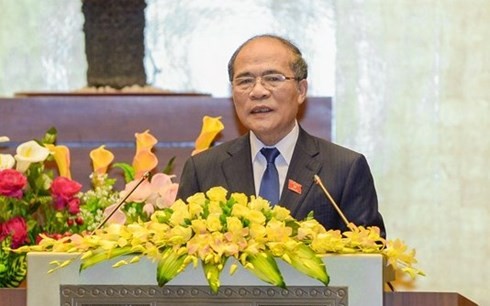(VOVworld)- Over the past 70 years, Q&A sessions have reflected the National Assembly’s democracy and reforms. They have enhanced the legislative body’s supervisory role.

National Assembly Chairman Nguyen Sinh Hung |
The first Q&A session was democratic, frank
The first Q&A session of the National Assembly took place on October 31st, 1946, during the 2nd session of the 1st National Assembly. In a democratic and frank atmosphere, National Assembly deputies and representatives of the people raised a number of questions to Ministers and President Ho Chi Minh. More than 80 questions concerning such things as price controls, drug quality, and slow delivery and shortage of school books were asked. The Q&A session lasted until midnight. Historian Duong Trung Quoc said: “The Q&A session took place in a serious, democratic, and open atmosphere. At this session, the Head of the Government, President Ho Chi Minh, replied to the questions. After this session, President Ho Chi Minh said the questions reflected the growth in ideological thinking of the people and their interest in national issues”.
Q&A sessions have been reformed
Q&A sessions at the National Assembly were suspended for a long time for various reasons such as war. The session was resumed at the 8th National Assembly in the 1987-1992 tenure. At the mid-term session of the 9th National Assembly in 1994, the Q&A session was broadcast live on radio and TV for the first time. Since then, the Q&A session has become one of the most anticipated activities at the National Assembly. At the 4th session of the 12th National Assembly, the National Assembly released a Resolution on Q&A sessions asking for a follow-up on questions raised.
National Assembly deputies have fully exercised their right to have their Q&A questions answered. Those who answer the questions are motivated to improve their competency and accountability to the people and the National Assembly. Between 150 and 200 questions were sent to the 11th National Assembly and between 200 and 300 to the 12th and the 13th National Assemblies. Most questions have concerned national issues and people’s livelihoods.
At the 13th National Assembly, the Q&A session was reformed dramatically. For the first time, the Q&A session included Ministers, Chiefs of sectors and all Cabinet members. Questions weren’t publicized in advance. Secretary General of the National Assembly Nguyen Hanh Phuc said: “The Q&A session of the 10th session of the 13th National Assembly was reformed. National Assembly deputies could question all Cabinet members about how they had honored their commitments during their term”.
The Q&A session has become one of the most vital activities of the National Assembly. Its content, formats and procedures have been reformed to strengthen the National Assembly’s oversight role.